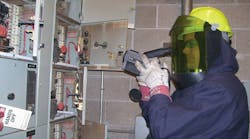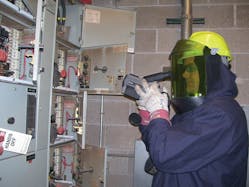"Do more with less” seems to have become a necessary catchphrase in today’s society. Regardless of how big your company is, what markets you serve, or where you are located, you undoubtedly face the exact same reality as the rest of the industry — do more with less, do it faster, and do it smarter. This “new normal” has made it challenging for manufacturing and industrial companies to keep up with the increasing demands of occupational health and safety regulations. This is especially true when it comes to electrical safety, which is one of the most rapidly evolving areas of regulatory compliance.
Maintenance staffs are smaller than they used to be, yet electrical safety performance expectations are on the rise. The 2012 edition of NFPA 70E, “Standard for Electrical Safety in the Workplace,” recently published another set of significant changes, and government enforcement is at an all-time high. Companies must now adhere to OSHA guidelines as well as insurance carrier recommendations that require annual infrared testing, switchgear testing, and other assessments. Needless to say, many companies find themselves overwhelmed with today’s electrical safety requirements — and most do not have the internal resources to manage electrical risk. They simply need help.
Identifying the need for support
Faith Technologies, headquartered in Menasha, Wis., is one electrical service contractor that has answered this call for help. The company’s Electrical Risk Management program offers comprehensive electrical risk assessments that support NFPA 70E safety compliance, efficiency, and cost savings.
The firm recognized the need, and felt it had a responsibility as a leader in the industry to make this move. After realizing how many customers could end up suffering financially because of electrical failures that could easily be avoided, Faith Technologies developed a service to help them.
The company began offering its Electrical Risk Management service in the early 1990s. Initially, it considered investing in a national franchise opportunity, but ultimately decided that the pre-established programs fell short of service expectations.
The company wanted to be able to customize the service according to its customers’ needs, and the prepackaged services just weren’t on par with the service level its workers could provide if it developed a program of its own.
Before it could begin offering the service, however, the company had to make a number of investments — both in equipment and resources. It began investing in a variety of specialty equipment, including power monitoring systems, testing equipment, and infrared cameras, which were newly available from the military for public use. The infrared cameras gave crews the ability to identify loose connections that were overheating and more accurately predict where potential equipment failures would occur. The company also developed its own unique software program for client data storage and reporting, and put an extensive two-year employee-training program in place to build up its staff of electrical risk field technicians.
NFPA 70E compliance drives growth
It didn’t take long for this new service to gain momentum. By the early 2000s, the program had experienced sizable growth, and was serving customers all across the United States.
According to company executives, the NFPA 70E standard was the driving factor behind the program’s success. OSHA began to step up its enforcement of the standard, which made electrical safety a huge risk and liability topic throughout the industry.
Major insurance risk carriers promptly followed suit. Soon companies like FM Global and Sentry Insurance were making electrical safety recommendations and suggesting that customers conduct annual electrical evaluations — evaluations that would assess compliance with the NFPA 70E regulations as well as the NFPA 70B standard, which regulates how to test and maintain electrical switchgear and systems.
While the NFPA 70E standard was not new, its ambiguity left facility and safety directors perplexed. The standard was quite challenging to interpret, and many companies across the country found themselves with more questions than answers.
The NFPA 70E standard has been around for a long time, but many industry experts agree that it’s not written very concisely. The requirements are so open-ended that it’s difficult for most facility directors or safety directors to know if they are interpreting the requirements correctly.
Soon, companies were realizing just how difficult it would be to manage the heightened electrical safety requirements on their own. Aside from the code complexities, internal resources were extremely limited. Facility and maintenance employees had hundreds of tasks to manage. Ultimately, it was unrealistic — and fiscally irresponsible — to ask them to manage electrical risk as well. If it wasn’t an employee’s core responsibility, it was difficult to retain the specialized knowledge that was needed to perform the tasks properly.
Faith Technologies was in the right spot at the right time. When customers started asking for help, the firm had the right service to offer them.
Service-based approach proves successful
Today, Faith Technologies has 16 full-time licensed electricians specially trained in electrical risk management, as well as CAD technicians, engineers, and project coordinators who support them. The field technicians travel throughout the United States, visiting customers on-site and helping them to develop custom electrical safety programs for their specific facility’s needs.
The success of the Electrical Risk Management program is centered on a collaborative six-step process (outlined below) to achieving electrical compliance:
1) Field NFPA 70E verification. To begin the process, licensed electrical technicians complete a physical signal tracing of the existing electrical systems, evaluating the equipment labeling systems for better lockout/tagout (LOTO) implementation and performing infrared scans to pinpoint any system faults ahead of any unplanned failures.
2) One-line prints. One-line drawings are custom designed based on actual system tracings and LOTO confirmations. Then, they are carefully reviewed with each customer to ensure they meet long-term end-user goals.
3) Engineering. Evaluations are performed using engineering software, including short circuit calculations, selective coordination, arc flash values, and PPE recommendations, along with recommendations for improving risk levels on existing equipment.
4) Labeling. Technicians implement thorough personal protective equipment (PPE) labeling best practices in compliance with ANSI Z535.4-1998 standards. The labels are custom designed to include: arc flash boundary, incident energy ratings, PPE needs, hazard classification, shock hazards, limited approach boundary, restricted approach boundary, prohibited approach boundary, and true “fed from” identification, among others.
5) Training. Sessions are conducted to educate the facility’s workers on OSHA 1910 references, NFPA 70E definitions, shock hazard prevention, LOTO procedures, and a variety of other electrical safety processes.
6) Long-term maintenance: Processes are put in place to maintain electrical safety assessments annually.
Faith Technologies has used this six-step process to help hundreds of companies throughout the country diagnose where they are struggling, pinpoint the safety areas to focus on, and then develop a sustainable electrical safety program that is tailored to their specific needs.
The goal is to create a safety program that is end-user driven, from the employees’ perspective.
Depending on the scope of the facility, an electrical risk management project can take anywhere from a couple days to several months. Because Faith Technologies’ technicians are certified electricians, they do all the work themselves — including opening and closing the equipment — and the team takes on all of the associated risk and liability.
Throughout the project, technicians uncover loose connections, identify code violations, and alleviate any pain points within the customer’s electrical systems. Instead of risking an unplanned outage or failure, which can lead to unforeseen costs, customers can immediately schedule a proper shutdown or maintenance sequence, allowing them to fix the problem safely — without losing any product or jeopardizing employee safety.
In addition to electrical safety improvements, the service can uncover other opportunities for cost savings and increased efficiency as well. For example, technicians often discover customers are spending more money than they should on power bills. They identify the issues in the facility that are creating the problem, and provide a cost-saving solution to fix them.
Customers have also cited a boost in employee productivity and morale. They gain a more responsive and qualified workforce, and quickly establish an enriched safety culture that permeates the entire organization.
The bottom line is Faith Technologies comes on-site to help its customers create a safe, compliant, and productive workplace that is sustainable for the future. This division also takes on all the work and liability — so customers can stay focused on the core needs of their business.
Building lasting customer relationships
Although the Electrical Risk Management program is most often scheduled as a one-time service, Faith Technologies has found that it regularly opens the door for future work opportunities.
The collaborative nature of the service creates an ideal environment for building client relationships and demonstrating the company’s compliance expertise. After a positive interaction with the program and its employees, customers have more confidence in Faith Technologies and its services, viewing the firm as an industry expert — someone they can trust to come on-site to their facility and offer reliable solutions to fix any problems they might face down the road. In time, it is those strong relationships that evolve into an ongoing service partnership.
According to managers of the program, if you earn customers’ respect and they value your input, that type of relationship comes naturally. Ultimately, the services, people, and products speak for themselves, and it opens doors.
Collaborative future of electrical risk management
In an era when so many employees are under pressure to do more with less, service programs like this will continue to be in high demand. Although the program serves a wide variety of market segments, the company has seen the largest growth in the industrial/manufacturing sector, specifically the food, paper, and pharmaceutical industries.
While a great deal of progress has already been made to keep workplaces safer, there are still many companies that have a long way to go. Electrical safety is — and will continue to be — one of the most important regulatory areas in occupational health and safety.
Downie is electrical risk management group manager of ERM at Faith Technologies, Appleton, Wis. He can be reached at [email protected].





